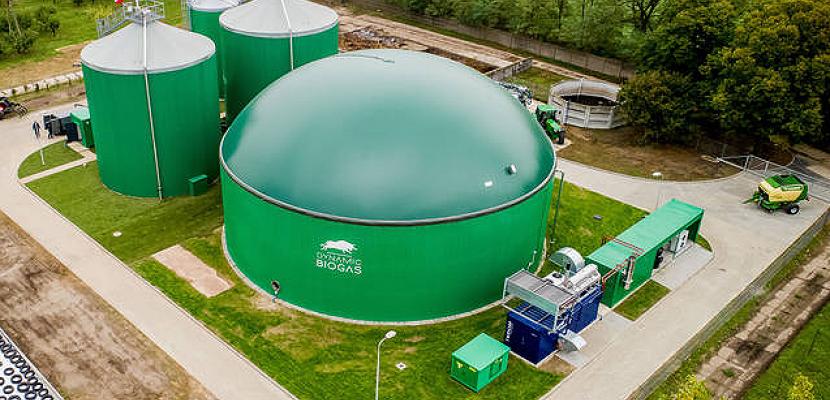Image

NEWbiogasDIMENSION: utilization of food organic waste in a highly efficient biogas plant
Published on 18 October 2021

Poland
This is the good practice's implementation level. It can be national, regional or local.
About this good practice
The innovative biogas plant launched in 2019 at the Agricultural and Fruit Experimental Station in Przybroda, belonging to the University of Life Sciences in Poznan, is an extremely modern installation, and thanks to the solutions used in it, it is even unique in Europe. This is due to both technical solutions (innovations in construction) and technological solutions (advanced solutions in the fermentation process). The installation is in line with the global trends in the development of the energy sector aimed at technologies using energy storage, renewable energy sources and ensuring universal energy security.
Usage of bio-waste and other re-food biomass can eliminate usage of maize and strongly increase the profitability of biogas plants.
The use of a developed biotechnological accelerator in a biogas plant allows for the use of waste substrates that cannot be used in typical biogas plant technologies. Such system significantly increases the efficiency of use of maize silage and allows for its substitution with re-food substrates, slaughter waste (including feathers, bones) as well as waste materials from agri-food processing. Accelerator enables the use of a wide range of different types of bio-components and smooth change in their proportions, depending on the present availability on the local market.
Usage of bio-waste and other re-food biomass can eliminate usage of maize and strongly increase the profitability of biogas plants.
The use of a developed biotechnological accelerator in a biogas plant allows for the use of waste substrates that cannot be used in typical biogas plant technologies. Such system significantly increases the efficiency of use of maize silage and allows for its substitution with re-food substrates, slaughter waste (including feathers, bones) as well as waste materials from agri-food processing. Accelerator enables the use of a wide range of different types of bio-components and smooth change in their proportions, depending on the present availability on the local market.
Resources needed
Each biogas plant consists of fermentation tanks made of acid-resistant steel. Apart from foundations, the whole biogas plant is delivered in containers (500 kWe installation: five 40-foot shipping containers, 1000 kWe: 8 shipping containers) and assembled on the spot.
Evidence of success
Technology and construction elements allow the fermentation process to be accelerated by 25% compared to installations based on maize. The installation not only processes agricultural waste and deodorizes it, but is also an element in the fight against smog in such villages as Przybroda. It is already replicated in several locations. Results achieved: Quick and easy assembly and commissioning on site, Modular construction - effective scaling of projects from 500KW to 5MW, A wide rof charges.
Potential for learning or transfer
The advantages of this innovative facility in Poland include:
* reduction of CO2 emission into the atmosphere in the amount of 6,800 MG
* use of methane for energy production, which will not be released into the atmosphere
* installation of a cogeneration engine with a capacity of 800 kW, which will generate electricity annually at the level of 4,300 MWh
* annual production of thermal energy in the amount of 4,300 MWh (15,480 GJ)
* target work in the so-called a peak biogas plant, producing electricity during peak demand hours, i.e. from 6:00 to 21:00
* very high energy efficiency of biogas plants at the level of 97%
* reduction of odour emissions from storage and spreading on manure fields
* providing thermal energy to heat the farm buildings and the possibility of connecting 500-800 local residential buildings to use this heat source, which will eliminate the effect of air pollution (smog in the countryside)
* reduction of CO2 emission into the atmosphere in the amount of 6,800 MG
* use of methane for energy production, which will not be released into the atmosphere
* installation of a cogeneration engine with a capacity of 800 kW, which will generate electricity annually at the level of 4,300 MWh
* annual production of thermal energy in the amount of 4,300 MWh (15,480 GJ)
* target work in the so-called a peak biogas plant, producing electricity during peak demand hours, i.e. from 6:00 to 21:00
* very high energy efficiency of biogas plants at the level of 97%
* reduction of odour emissions from storage and spreading on manure fields
* providing thermal energy to heat the farm buildings and the possibility of connecting 500-800 local residential buildings to use this heat source, which will eliminate the effect of air pollution (smog in the countryside)
Further information
Website
Good practice owner
You can contact the good practice owner below for more detailed information.
Organisation
Poznan University of Life Sciences (UPP), Dynamic Biogas Development Ltd (DBs)

Poland
Wielkopolskie
Contact
main specialist